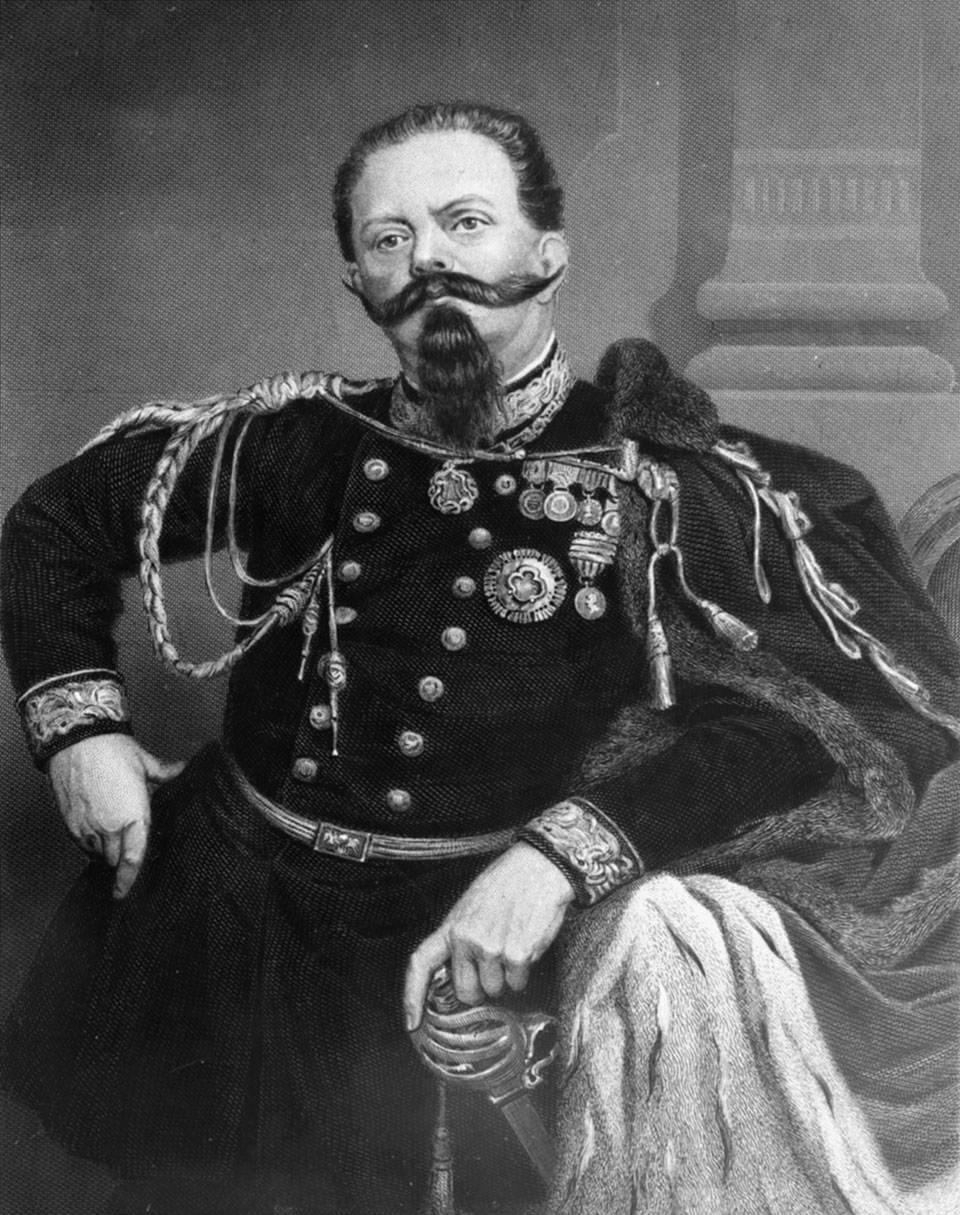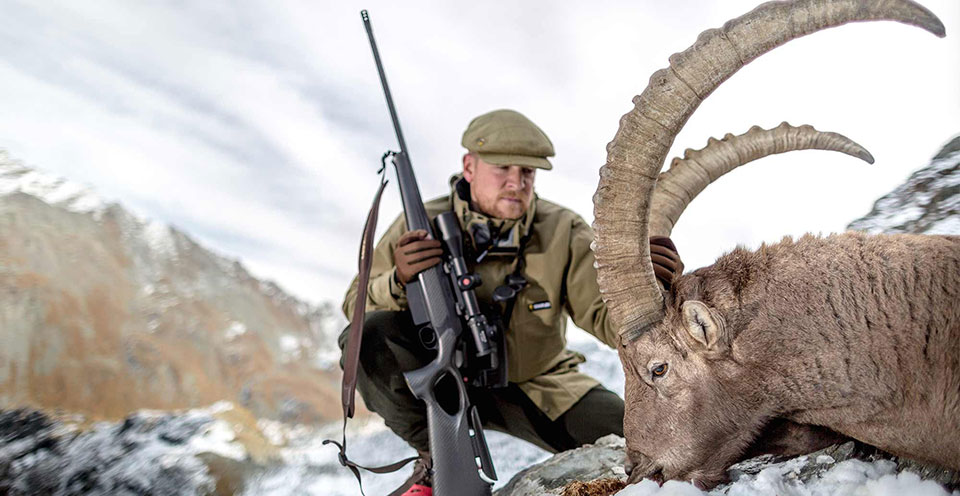The natural range of the Alpine Ibex (Capra ibex ibex) is the Alps. Originally the species existed in an area covered by the nations Austria, Switzerland, Italy, France, Germany (Bavaria), Slovenia and Lichtenstein.
The powerful animal has inspired humans for millennia with its seemingly super natural abilities to move uninhibited in virtually vertical mountain terrain. Hunting the Ibex with primitive weapons was an almost impossible physical challenge and for that reason, it was highly regarded among hunters of the day. Just as modern mountain hunters, they saw the challenges of the hunt as a bonus.
One of the more prolific early Ibex hunters was the emperor of the Holy Roman Empire Maximilian I who was known as a passionate hunter and outdoor writer. He despised the use of firearms and hunted exclusively with crossbows, spears and swords. It is not hard to realise the challenge…
Unfortunately the Ibex were not only hunted by passionate recreational hunters. Throughout its range, the hunting pressure on the species was very high. And when firearms made the hunt a lot easier in the beginning of the 16th century the hunt intensified. Illegal hunting was a major problem in spite of the monopoly on hunting held by the ruling class in most places. The poaching was motivated by all the same factors as poaching of our time.
They poached the Ibex for its meat and because it was a competitor to the grazing livestock animals of the villagers. They also killed the animals for the thrill of the hunt, the trophy and the massive local recognition that came with a str ong Ibex trophy. The poachers of the Alps were for long periods considered public heroes and in the literature of the day, poaching was openly romanticised. It was regarded as something extraordinarily manly to be a skilled Ibex hunter …. and attention from women has always been a very motivating factor for the physically strong (but mentally weak) sex….
The poachers of the Alps were for long periods considered public heroes...
Another strong motivation for Ibex poaching was the superstition of the time. Body parts of this iconic species were in high demand for use as amulets or ingredients in homeopathic medicine. Especially bezoars (“stones” found trapped in the gastrointestinal system”) and the small cross-shaped bone that forms in the heart of old bucks (Herzenkreuz) were extremely valuable. In other words, the species was struggling with the exact same incentives for poaching that makes rhino conservation difficult nowadays.
The Ibex population slowly succumbed to the growing pressure. The Ibex disappeared from Central Europe mountain by mountain and the scarcer the animals became the higher the demand for body parts grew. It really paid off to poach an Ibex. It was a self-perpetuating extermination process.
At the edge of the abyss.
During the 1600’s the Alpine Ibex became extinct in Switzerland and Germany. Around 1800 the Austrian population was also gone. The same was sadly true for all other populations except for a small number of animals on the Kingdom of Sardinias mountain properties in the border area between modern France and Italy. 50-100 animals survived in this area. It was probably less than 0,1 % of the original population. The area was a relatively small piece of land stretching from Gran Paradiso (in present day Italy) to Vanoise (in present day France). Naturally the genetic variation in the population was small, but the animals were all that were left and the hunting pressure (mostly from illegal hunting) was still high.
By around 1850, it was clear that the Alpine Ibex would become extinct within a few years unless radical conservation action were taken. In 1854 Victor Emmanuel II – the first king of the united Italy – decided to protect the remaining Ibexes by founding “The Royal Hunting Reservation Gran Paradiso”. He did nothing to hide the fact that his interest in the Ibex above anything else was hunting. The king himself was a passionate hunter and more importantly, the unique Ibex hunt was a very valuable political asset to the relatively small kingdom who used the hunt to nurture friendships with the heads of all the larger powers of Europe. Nobody really want to be in bad standing with the guy who controls the good hunting grounds. Of course, this only made sense if Italy wholeheartedly protected the Ibex population.
It was the final call for the Alpine Ibex and the conservation efforts were therefore not limited to passive legal protection of land. Active anti-poaching measures were also a very important part of the plan. The hunting reservation hired the most notorious local poachers and paid them to protect the animals as park rangers.
As it is usually the case this strategy proved successful. 60 years later the population in the Gran Paradiso reservation had grown to the impressive number of 3020 animals. The population had multiplied 30-fold in spite of the fact that regulated trophy hunting had been a part of the management of the area from the beginning.
There is no doubt that the Alpine Ibex was the pride and joy of the Italian king. In the early 1900’s the government of Switzerland became interested in reintroducing Ibex in the Swiss landscape and they politely asked permission to purchase a few individuals to start a breeding project. There were many lengthy negotiations about this but they all ended without results. Italy was clearly not interested in giving up their monopoly on Alpine Ibex.
Swiss officials chose to pay Italian poachers to catch live Ibex in the reservation and smuggle the animals over the border.
This obviously frustrated their neighbors in Switzerland. So much in fact, that in the end Swiss officials chose to pay Italian poachers to catch live Ibex in the reservation and smuggle the animals over the border. State organized poaching thus laid the foundation of the Swiss population of Alpine Ibex - the largest population in the world today.
In Italy the king gave the reservation to the Italian state at the end of the first world war. In 1922, Gran Paradiso became Italy’s first national park. However, the problems for the species were not quite over. The major problem was that the bulk of the world population was concentrated in a very limited area.
Obviously, this made the species extremely vulnerable to disease outbreaks, extreme weather, possible local armed conflicts etc. So the Italian government who had no interest in a hunting monopoly on a continent without hunters leading the nations decided to start using animals from the park to reintroduce the Ibex in other Alpine countries. By the mid 1960’s there were around 7,000 Alpine Ibex in Europe.
A decade later the population had doubled to around 15.000 animals. By the mid 1980’s they numbered 25,000 and today there is a stable population of more than 30,000 in free-ranging populations across its original range in the Alps. Furthermore, the species exists in small introduced (and mostly fenced) populations in Bulgaria, Argentina and Texas.
The free-ranging European population continues to grow and animals are still being reintroduced into areas that were home to the Ibex once upon a time…
The Alpine Ibex is no longer threatened, thanks to an Italian king who saved the species; in order to hunt it.
It would be perfectly sustainable to hunt the Ibex in most of the countries with free-ranging populations. However, hunting is currently only possible in Switzerland, Austria and Slovenia. In France, Italy and Germany Ibex are not hunted on a regular basis, but local culling sometimes brings down their numbers.
The best chances of going Alpine Ibex hunting as a hunting tourist is in Austria and Slovenia. In those countries, it is just a matter of buying a hunt (which can be very expensive). In Switzerland most of the hunting licenses go to local hunters.
It is typically no problem to go hunting in the introduced populations in Bulgaria, Argentina and Texas if you do not mind that the species is alien to the area and under a high-fence. Ibex hunting is expensive everywhere and considering their numbers and the challenges of the hunt it is never going to be cheap to hunt the king of the mountains.
Published by Vintage Guns Ltd on (modified )



